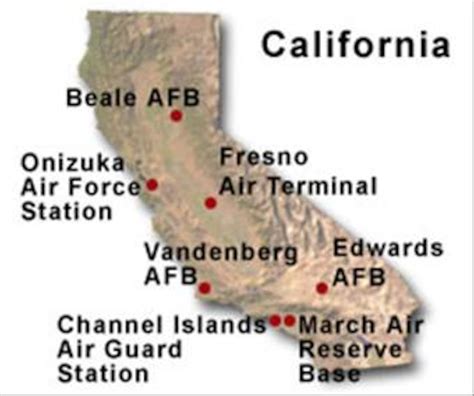The state of California is home to a significant number of Air Force bases, each playing a unique role in the country’s defense and military operations. These bases are strategically located to provide support for a wide range of missions, from training and logistics to research and development. In this article, we will delve into the world of Air Force bases in California, exploring their history, functions, and importance in the larger context of national security.
Historical Context: The Emergence of Air Force Bases in California
California’s strategic location on the West Coast made it an ideal place for the establishment of military bases, particularly those related to the Air Force, during the early 20th century. The state’s favorable climate, extensive coastline, and proximity to the Pacific Ocean provided a natural advantage for military aviation. The first Air Force bases in California were established during World War II, as the United States recognized the need to strengthen its defenses and prepare for potential attacks from the Pacific.
One of the earliest and most notable Air Force bases in California is the March Air Reserve Base, which was initially established in 1918 as the Alessandro Flying Training Field. Over the years, this base has played a significant role in various military operations, including World War II, the Korean War, and the Vietnam War. Today, March Air Reserve Base continues to serve as a critical component of the U.S. Air Force’s reserve component, providing aerial refueling, airlift, and other support missions.
Overview of Key Air Force Bases in California
California hosts several key Air Force bases, each with its unique mission and contribution to national defense:
Beale Air Force Base: Located near Marysville, Beale AFB is known for its role in reconnaissance and surveillance. It is home to the U-2 Dragon Lady and the RQ-4 Global Hawk, among other aircraft. The base’s strategic location allows for the collection of vital intelligence, supporting both national and international security efforts.
Edwards Air Force Base: Situated in Kern County, Edwards AFB is renowned for its involvement in the development and testing of new aircraft and weapons systems. It has been the site of numerous historic flights and has played a pivotal role in the advancement of military aviation technology. The base is also home to the Air Force Test Center, which conducts testing and evaluation of aircraft, space, and missile systems.
Los Angeles Air Force Base: Located in El Segundo, Los Angeles AFB serves as the headquarters for the Space and Missile Systems Center (SMC), which is responsible for the development, acquisition, and sustainment of space and missile systems. The base plays a critical role in the country’s space program, supporting a wide range of space-related activities, from launch operations to satellite management.
Travis Air Force Base: Positioned in Solano County, Travis AFB is a major logistics hub and home to the 60th Air Mobility Wing. The base is responsible for providing airlift and aerial refueling support to U.S. military operations worldwide. Its strategic location near the San Francisco Bay Area allows for efficient transportation of personnel, equipment, and supplies.
Vandenberg Air Force Base: Located on the Central Coast, Vandenberg AFB is primarily used for satellite launches and ballistic missile tests. It is also home to the 30th Space Wing, which manages the base’s launch and test operations. The base has played a significant role in the development of the country’s space program, supporting numerous satellite launches and missile tests over the years.
Impact and Importance of Air Force Bases in California
The presence of Air Force bases in California has a significant impact on both the local and national levels. Economically, these bases contribute to the state’s economy through employment, procurement, and infrastructure development. For example, a study by the California Economic Strategy Panel found that the state’s military bases generate billions of dollars in economic activity each year, supporting thousands of jobs and stimulating local economic growth.
Furthermore, the bases in California play a critical role in the country’s defense strategy, providing essential support for military operations worldwide. The state’s Air Force bases are involved in a wide range of activities, from training and logistics to research and development, ensuring that the U.S. military remains at the forefront of technological advancements and operational readiness.
Challenges Facing Air Force Bases in California
Despite their importance, Air Force bases in California face several challenges, including budget constraints, environmental concerns, and the need for modernization. The bases must balance their operational requirements with the need to reduce their environmental footprint, implementing sustainable practices and reducing waste. Additionally, the bases must adapt to changing technological advancements, ensuring that their infrastructure and equipment remain relevant and effective in supporting military operations.
Future Developments and Innovations
As the world continues to evolve, so too must the Air Force bases in California. The future of these bases will be shaped by emerging technologies, changing global dynamics, and the need for sustainable operations. For instance, the development of advanced unmanned aerial vehicles (UAVs) and the integration of artificial intelligence (AI) into military operations will require significant investments in infrastructure and training.
Moreover, the Air Force is exploring new concepts, such as the “Air Force We Need” initiative, which aims to modernize the force and prepare it for future conflicts. This initiative includes plans to expand the Air Force’s fleet of aircraft, develop new technologies, and enhance its cyber capabilities. As the Air Force continues to evolve, the bases in California will play a crucial role in supporting these efforts, driving innovation and ensuring the country’s military remains a dominant force in the world.
Conclusion
In conclusion, the Air Force bases in California are a testament to the state’s strategic importance in the country’s defense and military operations. From their historical roots to their current roles in supporting a wide range of missions, these bases have played and continue to play a vital role in ensuring national security. As the military landscape continues to evolve, the Air Force bases in California will remain at the forefront, driving innovation, supporting critical operations, and contributing to the state’s economy.
FAQ Section
What is the primary role of Beale Air Force Base in California?
+Beale Air Force Base is primarily known for its role in reconnaissance and surveillance, hosting aircraft such as the U-2 Dragon Lady and the RQ-4 Global Hawk.
Which Air Force base in California is involved in the development and testing of new aircraft and weapons systems?
+Edwards Air Force Base is renowned for its involvement in the development and testing of new aircraft and weapons systems, serving as the site for numerous historic flights and advancements in military aviation technology.
What is the role of Los Angeles Air Force Base in the U.S. space program?
+Los Angeles Air Force Base serves as the headquarters for the Space and Missile Systems Center (SMC), which is responsible for the development, acquisition, and sustainment of space and missile systems, playing a critical role in the country’s space program.
Which Air Force base in California is a major logistics hub?
+Travis Air Force Base is a major logistics hub, providing airlift and aerial refueling support to U.S. military operations worldwide through the 60th Air Mobility Wing.
What is the primary function of Vandenberg Air Force Base?
+Vandenberg Air Force Base is primarily used for satellite launches and ballistic missile tests, managed by the 30th Space Wing, which oversees the base’s launch and test operations.



